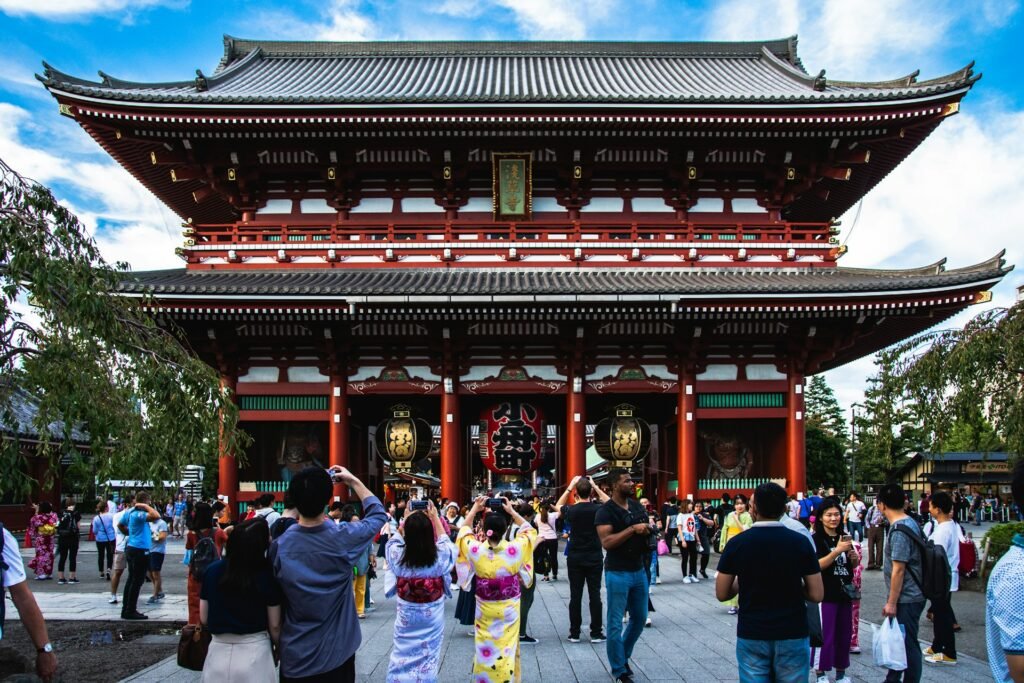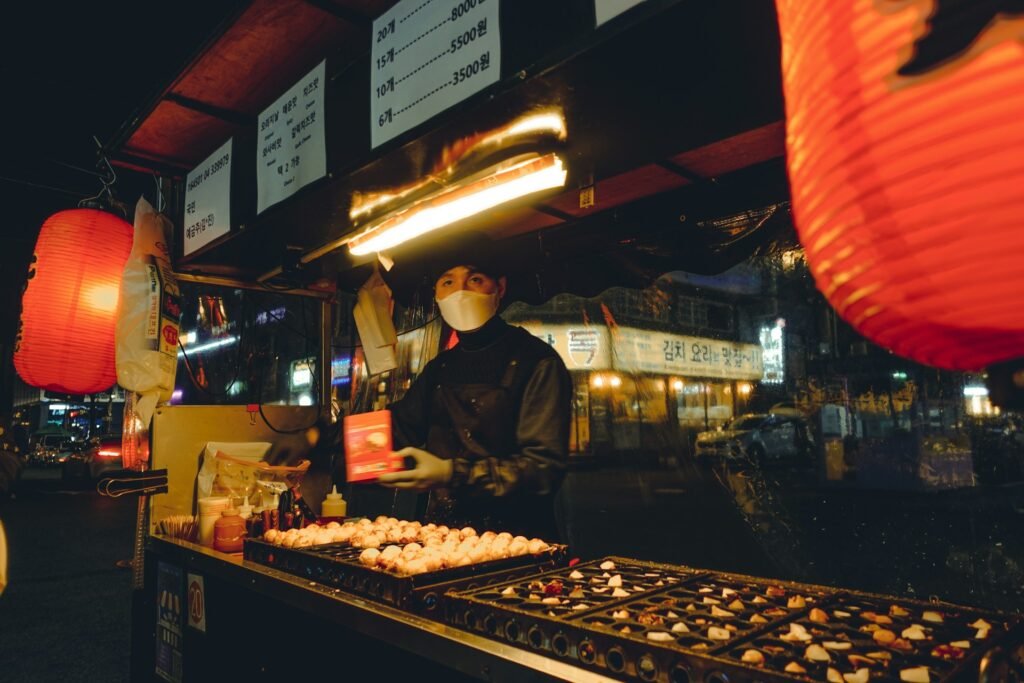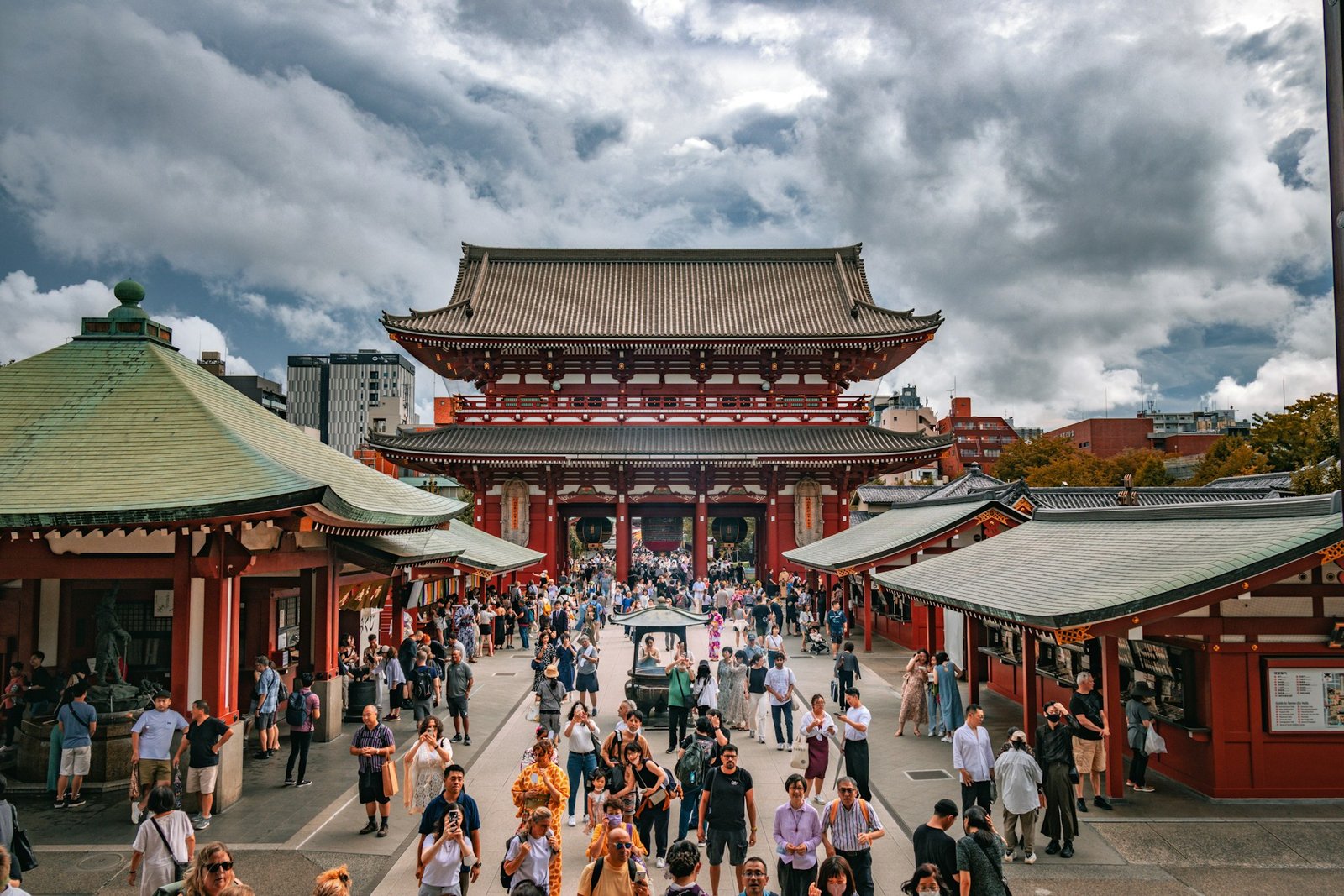Asakusa stands as Tokyo’s most authentic cultural district, where centuries-old traditions seamlessly blend with modern urban energy. Located in the city’s historic shitamachi (downtown) area, this captivating neighborhood offers visitors an unparalleled glimpse into Japan’s rich heritage while remaining easily accessible from Tokyo’s bustling modern centers. For travelers seeking to experience the soul of traditional Japan without leaving the capital, Asakusa represents the perfect destination for cultural immersion and authentic Tokyo travel experiences.
Table of Contents
The Rich History and Cultural Significance of Asakusa
Asakusa’s remarkable history spans over 1,400 years, beginning with the legendary founding of Sensoji Temple in 628 AD. According to temple lore, two fishermen brothers discovered a golden statue of Kannon, the Buddhist goddess of mercy, in the Sumida River. Despite repeatedly attempting to return the statue to the water, it consistently returned to them, leading to the establishment of what would become Tokyo’s oldest temple.
During the Edo period (1603-1867), Asakusa flourished as Japan’s premier entertainment district. The area became a vibrant hub for kabuki theaters, geisha districts, and various forms of popular entertainment that defined Tokyo’s cultural landscape. Tokugawa Ieyasu designated Sensoji as a guardian temple of Edo, cementing Asakusa’s importance in the city’s spiritual and cultural life.
Cultural Evolution Through the Centuries
The district’s entertainment legacy continued into the early 20th century, when modern attractions like movie theaters and amusement parks joined traditional forms of entertainment. While much of historical Asakusa was destroyed during World War II air raids, the area was rebuilt with careful attention to preserving its traditional character.
Today, Asakusa attracts over 30 million visitors annually, making it one of Tokyo’s most visited cultural destinations while maintaining its authenticity as a living, breathing community where traditions continue to thrive.
Sensoji Temple: Tokyo’s Spiritual Crown Jewel

Sensoji Temple stands as Asakusa’s undisputed centerpiece and Tokyo’s oldest Buddhist temple. The temple complex encompasses several significant structures, each with its own historical and spiritual importance:
Kaminarimon (Thunder Gate): The temple’s iconic entrance features a massive 4-meter-tall, 700-kilogram red paper lantern suspended between two guardian statues of Raijin and Fujin, the thunder gods. First built in the 10th century and rebuilt in 1960, this gate symbolizes protection from evil spirits and serves as a beacon of good fortune.
Hozomon Gate: The temple’s inner gate houses important Buddhist treasures on its second floor and displays enormous straw sandals that symbolize the strength needed to ward off demons.
Main Hall: The heart of Sensoji enshrines the sacred Kannon statue and serves as the primary worship area where visitors can participate in traditional Buddhist rituals.
Proper Temple Etiquette and Worship Practices
Understanding proper temple etiquette enhances the spiritual experience and shows respect for this sacred space. The traditional worship process follows these steps:
- Purification: Begin at the chozuya (purification fountain) to cleanse hands and mouth with the provided water
- Incense Ritual: Visit the incense burner and waft smoke over yourself for purification and blessing
- Prayer Offering: Approach the main hall, make a monetary offering in the collection box, and ring the bell if available
- Silent Prayer: Unlike Shinto shrines, Buddhist temples require silent prayer without clapping
- Fortune Reading: Consider drawing an omikuji fortune slip to receive guidance for your future
Nakamise Shopping Street: A Cultural Shopping Experience
Nakamise Shopping Street represents one of Japan’s oldest shopping thoroughfares, stretching 250 meters from Kaminarimon Gate to Sensoji Temple. Established during the Edo period, this historic marketplace has served temple visitors for centuries, evolving from simple tea and snack vendors to today’s diverse collection of nearly 90 shops.
The street’s name means “inside street,” reflecting its location within the temple grounds. Vendors originally gained permission to operate by voluntarily maintaining the temple approaches, establishing a tradition of community service that continues today.
Traditional Foods and Artisan Crafts
Nakamise Street offers an exceptional variety of traditional Japanese treats and authentic cultural products:
Traditional Sweets:
- Ningyo-yaki: Fish-shaped sponge cakes filled with sweet red bean paste, molded into shapes representing Asakusa landmarks
- Kibi-dango: Sweet rice dumplings made from millet flour and coated with kinako (soybean powder), traditionally served with matcha tea or warm sake
- Age-manju: Deep-fried sweet buns with various fillings including traditional red bean, pumpkin, sesame, and seasonal flavors
- Melon pan: Crispy, sweet bread with distinctive melon flavoring and crunchy exterior
Artisan Crafts and Souvenirs:
- Traditional yukata robes and folding fans featuring famous ukiyo-e prints
- Handcrafted wooden items and bamboo products
- Religious items including omamori (protective charms) and incense
- Authentic chopsticks with personalized engraving options
Transportation and Accessibility
Asakusa’s excellent transportation connections make it easily accessible from anywhere in Tokyo:
From Tokyo Station:
- Take JR Yamanote Line to Kanda Station (2 minutes)
- Transfer to Tokyo Metro Ginza Line to Asakusa (10 minutes)
Total journey time: approximately 15 minutes
From Shinjuku Station:
- Take JR Chuo Line to Kanda Station (10 minutes)
- Transfer to Tokyo Metro Ginza Line to Asakusa (10 minutes)
Total journey time: approximately 25 minutes
Airport Connections:
- Narita Airport: Keisei Skyliner to Ueno, then Ginza Line to Asakusa
- Haneda Airport: Keikyu Line to Shinagawa, then transfer to Asakusa Line direct to Asakusa
Local Transportation Options
Multiple train lines serve Asakusa Station, providing convenient access throughout Tokyo:
- Tokyo Metro Ginza Line: Direct connection to Shibuya, Ginza, and central Tokyo
- Toei Asakusa Line: Airport express connections and southern Tokyo access
- Tobu Skytree Line: Access to Tokyo Skytree and northern suburban areas
- Tsukuba Express: Regional connections to northeastern Japan
Cultural Experiences and Traditional Activities
Asakusa offers Tokyo’s most authentic kimono rental experiences, allowing visitors to immerse themselves in traditional Japanese culture. The district’s historical atmosphere provides the perfect backdrop for wearing traditional attire.
Popular Kimono Rental Services:
- Full-service packages including kimono selection, professional dressing, and hair styling
- Seasonal options featuring appropriate fabrics and colors for different times of year
- Photography services with professional photographers familiar with Asakusa’s most photogenic locations
- Group packages for couples, families, and friends seeking shared cultural experiences
Traditional Craft Workshops and Cultural Classes
Tea Ceremony Experiences: Participate in authentic Japanese tea ceremony lessons in traditional tea houses near Sensoji Temple. These sessions include instruction in proper etiquette, matcha preparation techniques, and the philosophical foundations of the tea ceremony.
Calligraphy and Art Classes: Learn traditional Japanese writing and painting techniques from master artists.
Food Sample Making: Create realistic plastic food displays at workshops in nearby Kappabashi district.
Seasonal Festivals and Events
Sanja Matsuri (May): Tokyo’s most spectacular traditional festival features portable shrine processions, traditional music, and cultural performances that attract over 3 million spectators. The 2025 festival runs from May 16-18.
Sumida River Fireworks Festival (July): This historic fireworks display dating back to the Edo period launches approximately 20,000 fireworks over the Sumida River, creating a spectacular summer celebration.
Asakusa Samba Carnival (August): A unique fusion of Japanese and Brazilian culture, this carnival celebration brings colorful parades and international entertainment to traditional Asakusa.
Seasonal Highlights Throughout the Year
Spring: Cherry blossom viewing along the Sumida River and traditional hanami celebrations
Summer: Traditional festivals, outdoor food stalls, and evening temple illuminations
Autumn: Golden Dragon Dance performances and beautiful fall foliage
Winter: New Year celebrations, traditional markets, and special temple ceremonies
Culinary Adventures in Asakusa
Asakusa’s culinary scene represents the pinnacle of traditional Tokyo dining, featuring restaurants that have served the community for generations:
Historic Establishments:
- Daikokuya Tempura: Operating since 1887, this legendary restaurant serves tempura fried exclusively in sesame oil, creating unique dark-colored, richly flavored dishes
- Kamiya Bar: Established in 1880 as Japan’s oldest Western-style bar, famous for its signature “Denki Bran” (electric brandy) cocktail
- Onigiri Yadoroku: Tokyo’s oldest onigiri specialty shop, recognized with Michelin Bib Gourmand status for seven consecutive years
Michelin-Recognized Dining:
Several Asakusa restaurants have earned Michelin recognition, offering exceptional dining experiences at reasonable prices:
- Asakusa Nagami: Michelin-selected for 2024 and 2025, specializing in seasonal Japanese cuisine
- Sugita: Michelin Bib Gourmand winner for four consecutive years, renowned for exceptional tonkatsu
Street Food and Local Specialties

Asakusa’s street food scene offers an incredible variety of traditional Japanese treats and regional specialties:
Must-Try Street Foods:
- Takoyaki: Octopus balls served with various regional sauces
- Yakitori: Grilled chicken skewers prepared over traditional charcoal
- Daigaku-imo: Candied sweet potatoes, a beloved autumn treat
- Matcha ice cream: Including the famous “world’s strongest” matcha concentration options
Modern Attractions and Scenic Views
The Tokyo Skytree, visible from throughout Asakusa, adds a modern element to the district’s traditional landscape. At 634 meters tall, it’s the world’s tallest free-standing tower and offers spectacular views of the city.
Best Viewing Locations:
- Asakusa Culture Tourist Information Center: Free rooftop observation deck with panoramic views of Sensoji Temple, Tokyo Skytree, and the Asahi Beer buildings
- Sumida Park: Riverside location offering excellent photo opportunities with Tokyo Skytree as backdrop
- Azuma Bridge: Ideal spot for capturing the contrast between traditional Asakusa and modern Tokyo architecture
Unique Architectural Landmarks
Asahi Beer Buildings: The distinctive golden “flame” sculpture atop the Asahi Beer headquarters, locally nicknamed the “golden poop,” represents one of Tokyo’s quirkiest architectural features. The adjacent Asahi Beer Tower, designed to resemble a glass of beer with foam, offers rooftop dining with spectacular city views.
Accommodation Options in Asakusa
Asakusa View Hotel: This 28-floor hotel offers stunning views of Tokyo Skytree and Sensoji Temple, with specially designed Tokyo Skytree View Rooms for optimal sightseeing. The hotel features multiple restaurants, a rooftop bar, and direct shuttle service to Tokyo Skytree.
The Gate Hotel Kaminarimon: Located steps from Kaminarimon Gate, this boutique hotel provides exceptional views and immediate access to Sensoji Temple. The rooftop bar offers panoramic vistas of Tokyo Skytree and the temple complex.
Budget-Friendly Options
Asakusa offers excellent budget accommodations that maintain quality and convenience:
Recommended Budget Hotels:
- Hotel Tavinos Asakusa: Modern amenities with convenient access to multiple train lines
- Asakusa Ryokan Toukaisou: Traditional Japanese-style accommodation offering authentic cultural experiences
- APA Hotel Asakusa Tawaramachi: Contemporary business hotel with compact but comfortable rooms
Practical Travel Tips and Recommendations
Optimal Visiting Hours: Early morning (around 8-9 AM) offers the most peaceful temple experience with fewer crowds. Evening visits provide beautiful illuminated temple views and a more serene atmosphere.
Seasonal Considerations:
- Spring and Fall: Ideal weather with comfortable temperatures and seasonal beauty
- Summer: Festival season with numerous cultural events but higher temperatures and humidity
- Winter: Fewer crowds and special New Year celebrations, but colder weather
Cultural Etiquette and Practical Advice
Temple Etiquette: Remove hats when entering temple buildings, speak quietly, and follow photography restrictions. Don’t walk and eat on temple grounds or shopping streets.
Shopping Tips: Bargaining is not customary in Japan. Prices are generally fixed, and quality is consistently high. Many shops accept only cash, so ensure adequate yen reserves.
Language Considerations: While many signs include English, learning basic Japanese phrases enhances the cultural experience. Many kimono rental shops and major attractions offer English-speaking staff.
Nearby Attractions and Extended Itineraries
Ueno: Just 5 minutes away by train, featuring museums, parks, and additional cultural attractions
Kappabashi Kitchen Town: Professional kitchenware district offering unique culinary tools and food sample workshops
Tokyo Skytree Town: Modern entertainment complex with shopping, dining, and observation decks
Day Trip Combinations
Asakusa serves as an excellent base for exploring multiple Tokyo districts in a single day:
- Morning: Asakusa temple visit and cultural activities
- Afternoon: Ueno museums and park exploration
- Evening: Akihabara electronics district or Ginza upscale shopping
Conclusion
Asakusa represents the heart and soul of traditional Tokyo, offering visitors an unmatched opportunity to experience authentic Japanese culture within a modern metropolitan setting. From the sacred grounds of Sensoji Temple to the bustling energy of Nakamise Shopping Street, every corner of this historic district tells a story of Japan’s rich cultural heritage.
Whether seeking spiritual enrichment, cultural immersion, culinary adventures, or simply a respite from Tokyo’s urban intensity, Asakusa delivers experiences that resonate long after your visit ends. The district’s unique ability to maintain its traditional character while embracing thoughtful modernization makes it an essential destination for any Tokyo traveler seeking to understand the depth and beauty of Japanese culture.
Plan your Asakusa adventure with confidence, knowing that this remarkable district offers something meaningful for every traveler. From budget-conscious backpackers to luxury-seeking tourists, from culture enthusiasts to casual sightseers, Asakusa welcomes all visitors with the warmth and authenticity that have defined this special corner of Tokyo for over 1,400 years.
